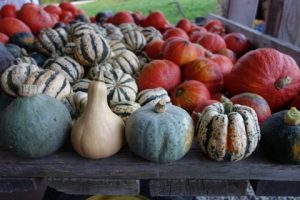 October is the month of final abundance. Not only is there a sudden profusion of fall cooking greens—bok choi, tahtsai, mei qing choi, gai-lan, broccoli raab, turnip greens, mustard greens, kale, and collards —there are the amazing salad greens—lettuces with their leaves growing thicker and tastier with the cool weather, fancy mustard greens (pizzo, ruby streaks, golden frill, and the incredible fall arugula.
October is the month of final abundance. Not only is there a sudden profusion of fall cooking greens—bok choi, tahtsai, mei qing choi, gai-lan, broccoli raab, turnip greens, mustard greens, kale, and collards —there are the amazing salad greens—lettuces with their leaves growing thicker and tastier with the cool weather, fancy mustard greens (pizzo, ruby streaks, golden frill, and the incredible fall arugula. In addition, we are entering the heavy root season, extracting loads of celery root, parsnips, turnips, daikon, roseheart radish, jerusalem artichokes, potatoes, sweet potatoes, burdock, and more.
In addition, we are entering the heavy root season, extracting loads of celery root, parsnips, turnips, daikon, roseheart radish, jerusalem artichokes, potatoes, sweet potatoes, burdock, and more.
On top of that, there is the full complement of winter squash and pumpkins—including old favorites like acorn and butternut, and new favorites like red kuri and kabocha, delicata and sugar loaf, plus pie pumpkins, cheese pumpkins, and the lovely bronze Winter Luxury.
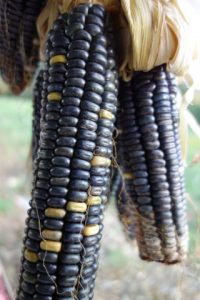 And now is the time to get your winter’s supply of popcorn (white, yellow, black, and strawberry) and freshly ground cornmeal for heirloom varieties such as Bloody Butcher, Oaxaca Green, and Hopi Blue.
And now is the time to get your winter’s supply of popcorn (white, yellow, black, and strawberry) and freshly ground cornmeal for heirloom varieties such as Bloody Butcher, Oaxaca Green, and Hopi Blue.
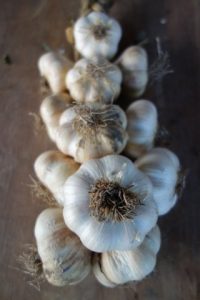 Last but not least, it’s time to buy allium braids – garlic, shallot, and onion – beautiful and useful kitchen hangings that give you that special boost that only alliums can.
Last but not least, it’s time to buy allium braids – garlic, shallot, and onion – beautiful and useful kitchen hangings that give you that special boost that only alliums can.
On the one hand, we revel in this autumn abundance. On the other hand, we know this beautiful abundance will be short-lived. Those two hands are part and parcel of wabi-sabi, a Japanese concept that is hard to translate, but is illustrated in the brief life of a plum blossom, the earthy aroma of autumn leaves beginning to decay, the emptiness of a field waiting for winter. It is hard to define wabi-sabi in English. In fact, from all I’ve read and heard, it’s not easy in Japanese either. The concept correlates with the core concepts of Buddhism: all things are impermanent; all things are imperfect.
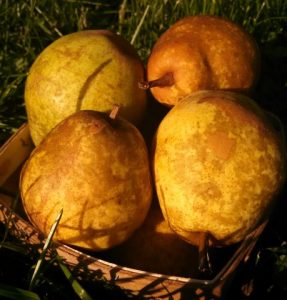 The “wa” in wabi-sabi means subdued refinement or solemnity. “Sabi” comes from the character meaning lonely or sad, but when used in wabi sabi it means the kind of beauty that flows from inside an old object, like the green patina on old copper, or lichens that transform an old rock into a beautiful swirl of patterns and colors.
The “wa” in wabi-sabi means subdued refinement or solemnity. “Sabi” comes from the character meaning lonely or sad, but when used in wabi sabi it means the kind of beauty that flows from inside an old object, like the green patina on old copper, or lichens that transform an old rock into a beautiful swirl of patterns and colors.
The rural Midwest is full of wabi-sabi, the result of a half-century of farm policy that has unintentionally decimated farming communities. A drive through the countryside reveals wooden barns and corn cribs slowly collapsing in on themselves, old trucks left to rust behind a shed or in the woods, and here and there in the endless miles of corn and soy, a few old trees along the road, erect as tombstones, announcing where a farmstead once stood. The only thing proliferating in these rural communities, it seems, are the graveyards, slowly biting off more of the surrounding fields year by year. This is a thought more bitter than the bittersweet of wabi-sabi.
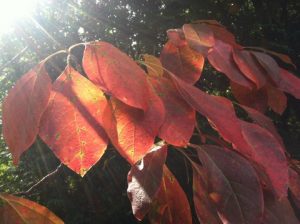 But wabi-sabi is a fact of nature—corn cribs crumble, basil and tomato plants blacken, and beautiful autumn leaves fall. With each swelling breeze and each falling leaf, my chest swells with love—for the beauty of abundance and the abundance of autumnal beauty, for the glowing trees and shimmering sky, for the wind returning leaves to earth, for the sweet smell of decay rising up with morning mist.
But wabi-sabi is a fact of nature—corn cribs crumble, basil and tomato plants blacken, and beautiful autumn leaves fall. With each swelling breeze and each falling leaf, my chest swells with love—for the beauty of abundance and the abundance of autumnal beauty, for the glowing trees and shimmering sky, for the wind returning leaves to earth, for the sweet smell of decay rising up with morning mist.
So enjoy this wabi-sabi season, and its abundance of beauty, before the bitter winter winds blow!


